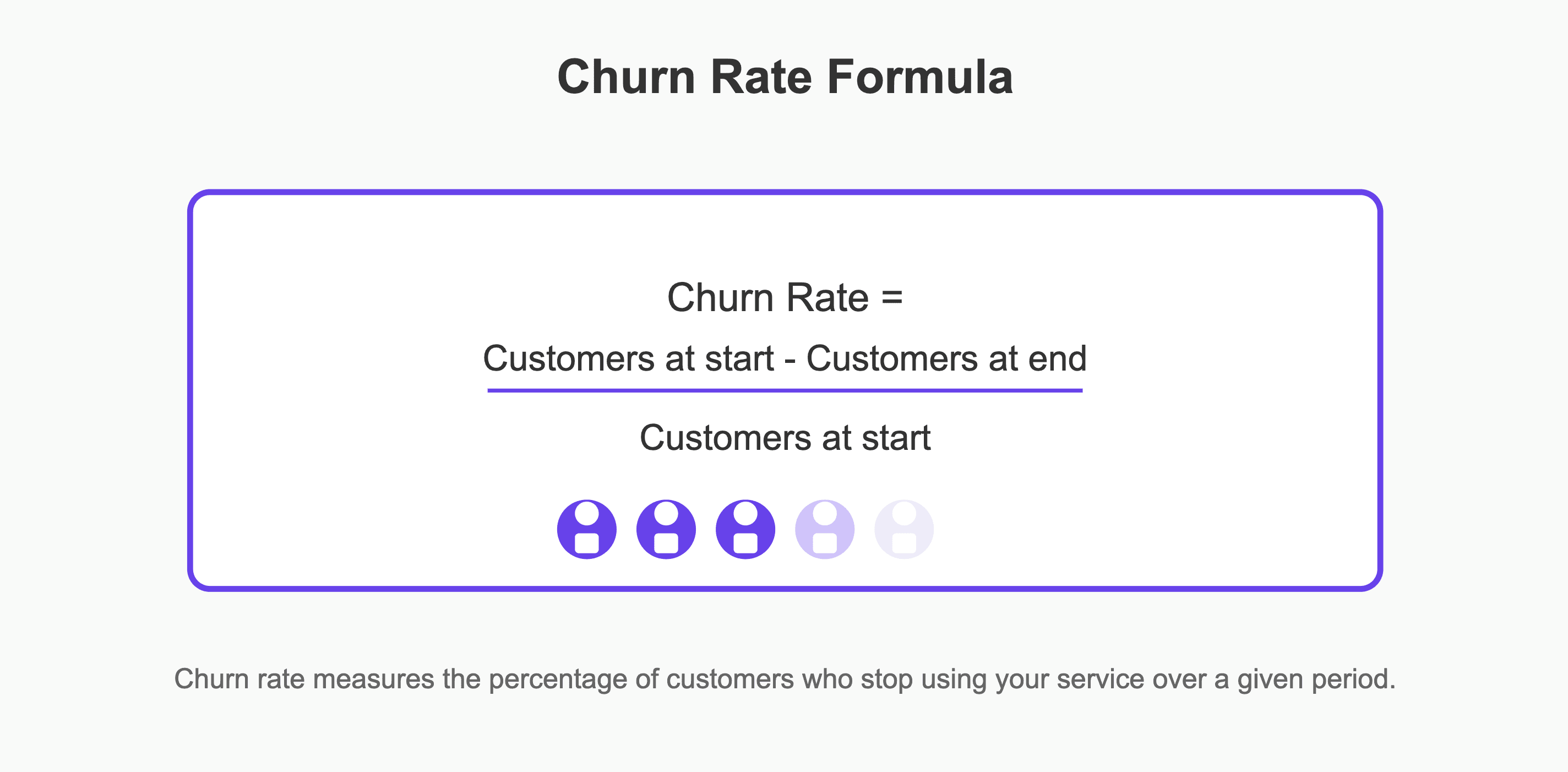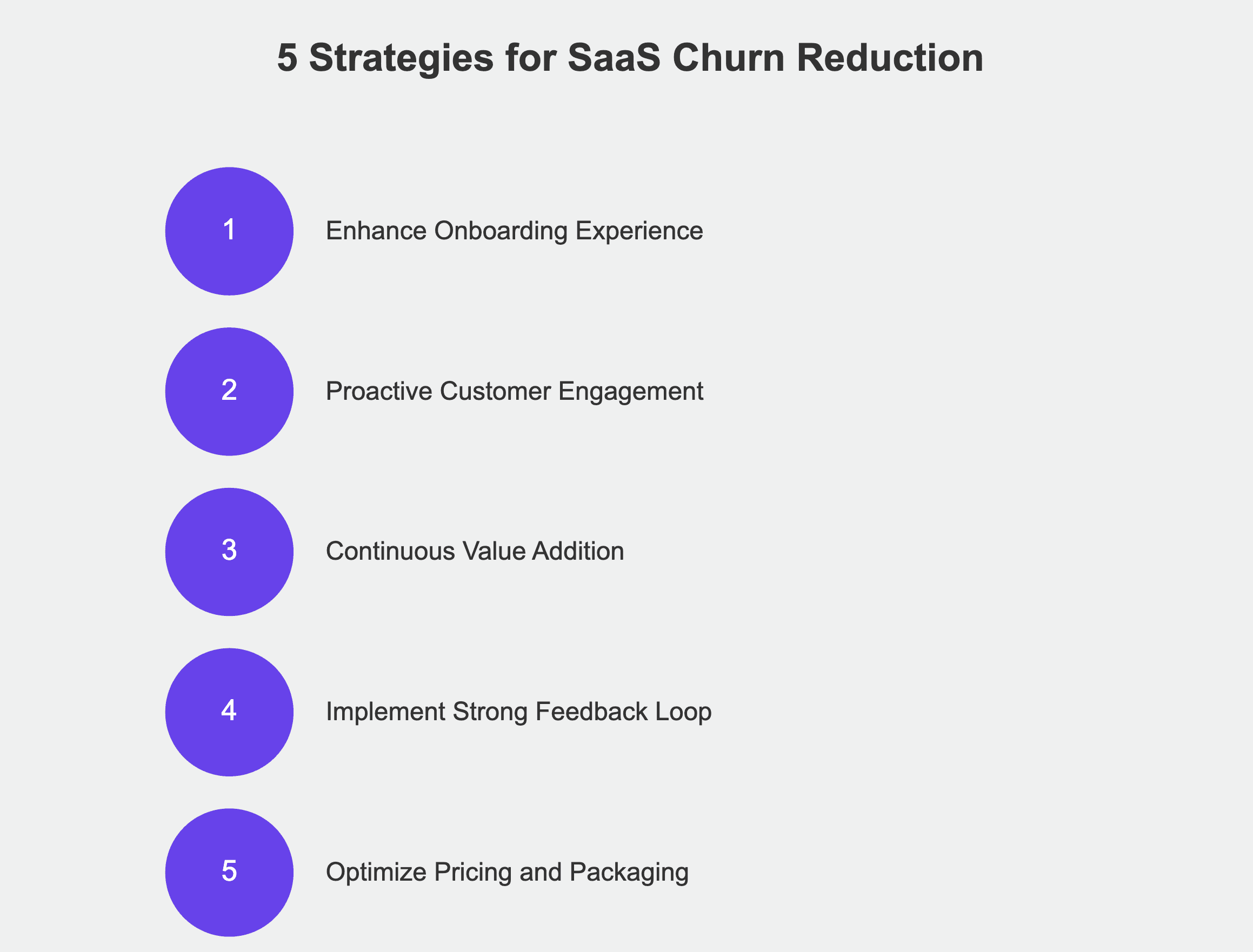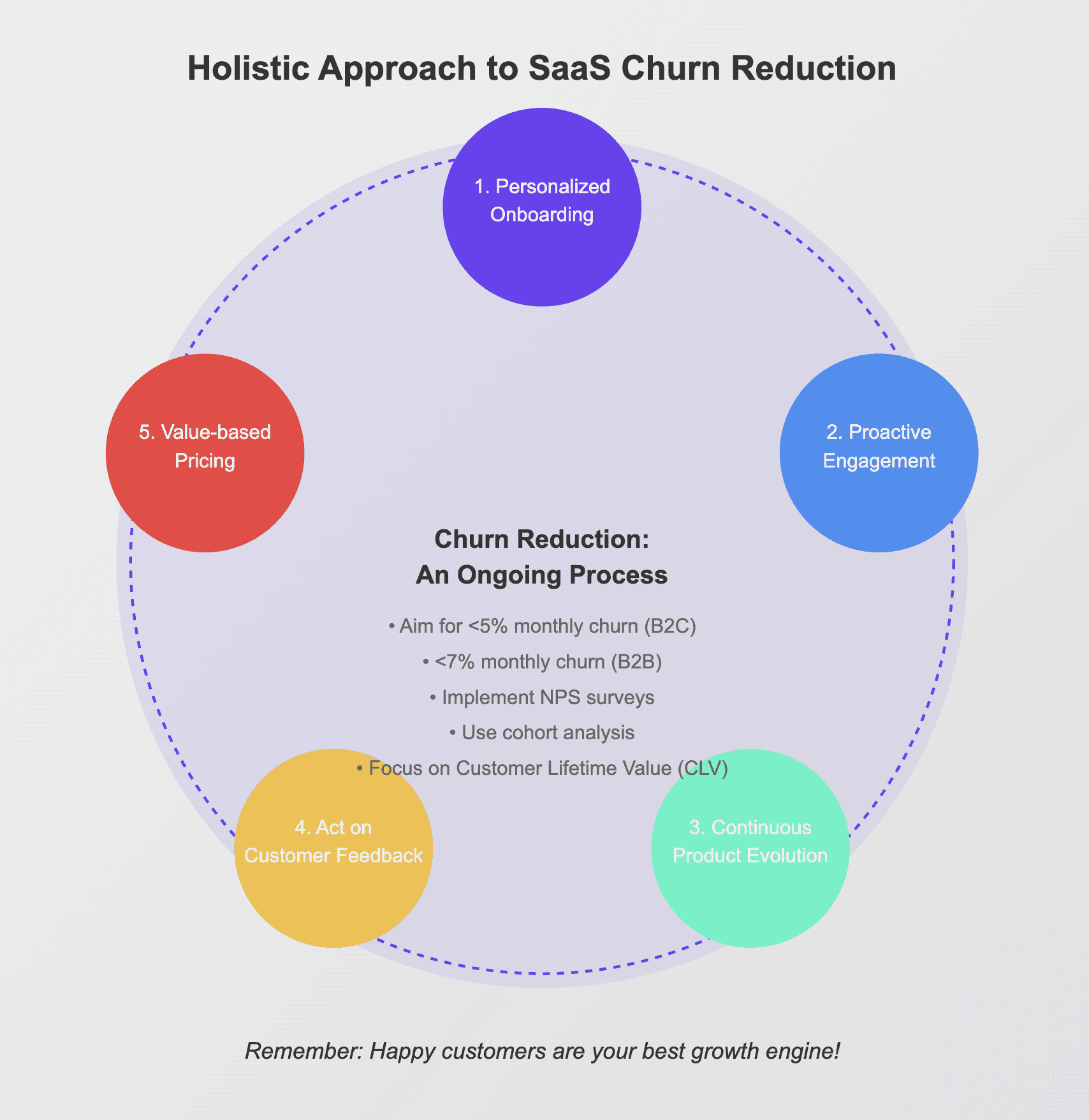
SaaS Churn Reduction Playbook: 5 Strategies for Success

by
Wiktoria Slowikowska
Oct 8, 2024
Identify and convert your most valuable users
Sign Up
Customer retention is the cornerstone of sustainable growth. This guide delves into the critical concept of churn reduction and explores five powerful strategies to keep your customers engaged and loyal. By the end, you'll have a robust toolkit to tackle churn head-on and drive long-term success for your SaaS business.
Understanding Churn

Churn, in essence, is the rate at which customers stop using your service. It's a metric that can significantly impact your company's future. Let's examine why churn is so crucial:
Revenue Loss: Each churned customer represents lost recurring revenue, directly impacting your bottom line. This loss compounds over time, potentially leading to significant financial setbacks.
Increased Customer Acquisition Costs: It's typically more expensive to acquire new customers than to retain existing ones. High churn rates force companies to allocate more resources to acquisition, which can be unsustainable in the long run.
Stunted Growth: High churn can offset new customer acquisitions, leading to stagnant growth. This creates a challenging environment for scaling your business and attracting investors.
Negative Brand Perception: Churned customers may share their negative experiences, impacting your brand reputation. This word-of-mouth effect can make it harder to attract new customers and partnerships.
To calculate your churn rate, use this formula:

SaaS companies aim for low customer churn - ideally 3% monthly or 8% yearly. However, a 2022 study found the actual median yearly churn was 13%, showing many companies struggle to keep customers long-term.
Now, let's explore five powerful strategies to combat churn and foster customer loyalty.

Strategy 1: Enhance the Onboarding Experience
A smooth, intuitive onboarding process sets the stage for a long-lasting customer relationship. Here's how to optimize your onboarding:
Create Interactive Tutorials: Guide users through your product's key features with step-by-step walkthroughs. Utilize tooltips, pop-ups, or short videos to explain complex functionalities. For example, Slack uses a Slackbot to guide new users through basic features, making the learning process interactive and engaging.
Personalize the Welcome: Tailor the onboarding experience based on the user's role, industry, or specific needs. This could involve customized dashboards or feature recommendations. Salesforce, for instance, asks new users about their role and company size to provide a tailored initial setup, ensuring relevance from the start.
Implement a Progress Tracker: Show users how far they've come in the onboarding process and what steps remain. This gamification element can boost engagement and completion rates. LinkedIn's profile completion bar is an excellent example of this in action, motivating users to provide more information and engage with the platform.
Offer Human Touchpoints: For high-value accounts, consider assigning dedicated customer success managers to guide them through the onboarding process personally. Zendesk offers personalized onboarding sessions for its enterprise customers, ensuring they get maximum value from the start and feel supported in their journey.
Follow Up Regularly: Send a series of onboarding emails over the first few weeks, each focusing on a different aspect of your product. This approach helps prevent information overload and keeps users engaged over time. Grammarly does this well, sending regular tips and feature highlights to new users, gradually expanding their product knowledge.
Measure and Optimize: Use analytics to track how users move through your onboarding process. Identify where users drop off and continuously refine these pain points. Tools like Mixpanel or Amplitude can help you visualize this user journey, providing invaluable insights for ongoing improvements.
Strategy 2: Proactive Customer Engagement
Don't wait for your customers to reach out with problems. Be proactive in your communication to build stronger relationships and identify issues before they lead to churn.
Implement a Regular Check-in Schedule: Use email, in-app messages, or even phone calls to touch base with customers. The frequency can vary based on the customer's lifecycle stage and product usage. For example, a new customer might receive weekly check-ins for the first month, then monthly thereafter. This consistent communication helps maintain engagement and allows you to address concerns promptly.
Offer Ongoing Education: Host webinars, create video tutorials, or write blog posts about advanced features and use cases. This not only helps customers get more value from your product but also positions you as an industry expert. HubSpot's Academy is a prime example of comprehensive ongoing education, offering free online training for marketing, sales, and customer service professionals.
Celebrate Customer Milestones: Acknowledge achievements like "1 year with us," "100th project completed," or "1000th customer served using our platform." This personal touch shows that you value their business and are invested in their success. Asana, for example, displays a celebratory unicorn animation when users complete tasks, adding a fun element to productivity and reinforcing positive user behavior.
Use Data to Drive Engagement: Analyze user behavior to identify customers who might be struggling or underutilizing your product. Reach out with targeted assistance or feature recommendations based on their usage patterns. Netflix's recommendation engine is a sophisticated example of data-driven engagement, continually analyzing viewing habits to suggest relevant content and keep users engaged.
Create a Community: Foster a space where customers can interact with each other, share best practices, and provide peer support. This could be a forum, Slack channel, or regular user meetups. Atlassian's community forums are a great example of a thriving user community, where customers can find solutions, share ideas, and connect with other users, enhancing their overall experience with the product.
Implement a Customer Health Score: Develop a scoring system that takes into account various factors like product usage, support ticket frequency, and engagement with your content. Use this score to prioritize your outreach efforts and predict potential churn risks. This proactive approach allows you to intervene before a customer reaches the point of churning.
Strategy 3: Continuous Value Addition
To reduce churn, your product needs to continuously evolve and provide value. Here's how to ensure your SaaS offering stays relevant and indispensable:
Maintain a Public Roadmap: Share your product development plans with customers. This builds excitement for upcoming features and shows that you're actively improving the product. Trello, for instance, uses a public Trello board to share its own product roadmap. This transparency not only keeps customers engaged but also allows them to plan their own workflows around upcoming features.
Implement Customer-Driven Development: Regularly collect and act on customer feedback. Use surveys, interviews, and usage data to inform your product decisions. UserVoice is a tool that many SaaS companies use to gather and prioritize customer feedback. By involving customers in the development process, you ensure that your product remains aligned with their needs and expectations.
Offer Seamless Integrations: Partner with complementary tools to create a more comprehensive solution. This increases the switching costs for customers and provides added convenience. Zapier has built its entire business model around providing seamless integrations between various SaaS tools. By expanding your product's ecosystem, you make it more valuable and harder for customers to leave.
Provide Exclusive Resources: Offer ebooks, templates, or industry reports exclusively to your subscribers. This adds value beyond your core product offering. Moz, an SEO software company, provides its customers with exclusive access to industry research and SEO guides. These resources not only enhance the product's value but also position your company as an industry leader.
Personalize the User Experience: Use AI and machine learning to tailor the product experience to each user's needs and preferences. This could involve personalized dashboards, smart feature recommendations, or predictive analytics. Amazon's product recommendations are a classic example of personalization driving engagement. By making your product more relevant to each user, you increase its perceived value and utility.
Continuous Feature Releases: Regularly release new features or improvements, even if they're small. This keeps your product fresh and shows active development. However, be sure to communicate these updates effectively to your users. Companies like Slack excel at this, regularly introducing new features and improvements while keeping users informed through release notes and in-app notifications.
Strategy 4: Implement a Strong Feedback Loop
Your customers' voices are goldmines of insights. Establish a robust feedback system to identify issues early and make customers feel heard. Here's how:
Use Multiple Feedback Channels: Offer in-app surveys, email questionnaires, and periodic Net Promoter Score (NPS) surveys to gather diverse feedback. Typeform, a survey tool, uses its own product to gather feedback from its users, showcasing the tool's capabilities while gathering valuable insights. This multi-channel approach ensures you capture feedback from users with different preferences and at various touchpoints.
Act on Feedback Visibly: When you implement changes based on customer suggestions, make sure to communicate this back to the customer. This shows that you value their input and are responsive to their needs. Notion does this well, often crediting user suggestions when announcing new features. This practice not only improves your product but also strengthens customer relationships.
Implement a Customer Advisory Board: Invite key customers to provide regular, in-depth feedback on your product and roadmap. This not only provides valuable insights but also strengthens relationships with important accounts. Salesforce's IdeaExchange is a public version of this concept, allowing customers to submit and vote on ideas for product improvements.
Monitor Social Media and Review Sites: Keep an eye on what customers are saying about your product online. Respond promptly to concerns and use this feedback to inform your product development. Tools like Mention or Hootsuite can help automate this process. This proactive approach to customer sentiment can help you address issues before they lead to churn.
Use AI for Sentiment Analysis: Implement tools that can analyze customer interactions (e.g., support tickets, chat logs) to identify trends in customer satisfaction and potential churn risks. IBM Watson's Natural Language Understanding can be used for this purpose. This technology allows you to process large volumes of customer feedback efficiently, identifying patterns and sentiments that might be missed by human analysis alone.
Close the Loop: Always follow up with customers who provide feedback. Let them know how their input is being used, even if you're not able to implement their suggestion immediately. This shows that you value their time and input, fostering a sense of partnership with your customers.
Strategy 5: Optimize Your Pricing and Packaging
Sometimes, churn isn't about the product itself, but how it's presented and priced. Here's how to optimize your pricing strategy to reduce churn:
Offer Flexible Pricing Tiers: Ensure you have options that cater to different customer segments, from small businesses to enterprises. This allows customers to easily scale up or down based on their needs. Salesforce's tiered pricing model is a good example of this approach, offering different plans for businesses of various sizes and needs.
Implement Usage-Based Pricing: For some SaaS products, pricing based on actual usage can be more attractive than flat-rate models. This ensures customers feel they're getting value for their money. Amazon Web Services (AWS) is a prime example of usage-based pricing in action. This model can be particularly effective for products where usage can vary significantly between customers.
Provide Annual Billing Options: Offer a discount for customers who commit to annual plans. This not only reduces short-term churn but also provides more stable revenue for your business. Many SaaS companies offer a 10-20% discount for annual commitments. This approach encourages longer-term commitment while providing customers with a financial incentive.
Create a Transparent Pricing Page: Clearly communicate the value proposition of each pricing tier. Use comparison tables and FAQs to help customers choose the right plan. Mailchimp's pricing page is a good example of clear, transparent pricing information. By being upfront about your pricing, you build trust and help customers make informed decisions.
Offer a Downgrade Option: Instead of losing a customer entirely, give them the option to downgrade to a lower-tier plan. This can be a temporary solution during tough times, maintaining the relationship until they're ready to upgrade again. Slack allows users to easily switch between paid and free plans, providing flexibility that can prevent complete churn.
Implement a Win-Back Strategy: For customers who do churn, have a strategy in place to win them back. This could involve special offers, new feature announcements, or personalized outreach after a certain period. By maintaining a connection with churned customers, you increase the chances of bringing them back when their circumstances or needs change.
Real-World Success Stories
Dropbox's Onboarding: Dropbox reduced churn by 16% by implementing a gamified onboarding process. New users were guided through a series of tasks (like uploading their first file) and rewarded with extra storage space. This not only educated users but also showcased the product's value immediately.
Groove's Proactive Engagement: Help desk software company Groove reduced churn by 71% by implementing a proactive customer success program. They identified users who hadn't logged in for 7 days and reached out with personalized emails offering assistance. This simple step re-engaged many users who might have otherwise churned.
HubSpot's Education Focus: HubSpot has built a comprehensive education program, HubSpot Academy, which offers free online training for marketing, sales, and customer service professionals. This not only helps users get more value from HubSpot's products but also positions the company as a thought leader in the industry. The academy has contributed to increased user engagement and reduced churn.
Holistic Approach to Churn Reduction

As we conclude our exploration of churn reduction strategies, remember that the most effective approach combines elements from all these strategies. It's about creating a holistic customer experience that delivers value at every touchpoint.
Key takeaways:
Start strong with a personalized, engaging onboarding process.
Stay connected through proactive, data-driven engagement.
Continuously evolve your product based on customer needs and feedback.
Listen to your customers and act on their input.
Ensure your pricing and packaging align with the value you provide.
Remember, reducing churn is an ongoing process. Regularly review your metrics, gather feedback, and be willing to iterate on your strategies. By focusing on customer success and continuously delivering value, you're not just reducing churn – you're building a loyal customer base that will fuel your SaaS company's growth for years to come.
The world of SaaS customer retention is vast, and there's always more to discover. Consider exploring advanced topics like customer segmentation or predictive analytics for identifying at-risk accounts to further refine your churn reduction strategies.




